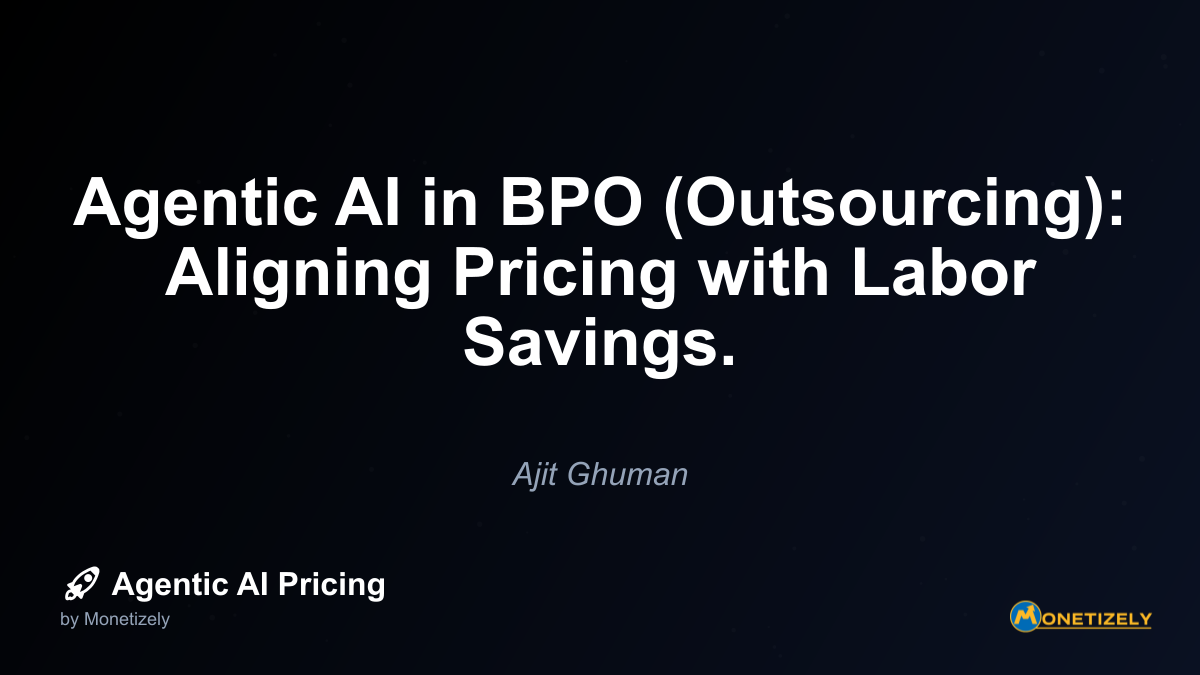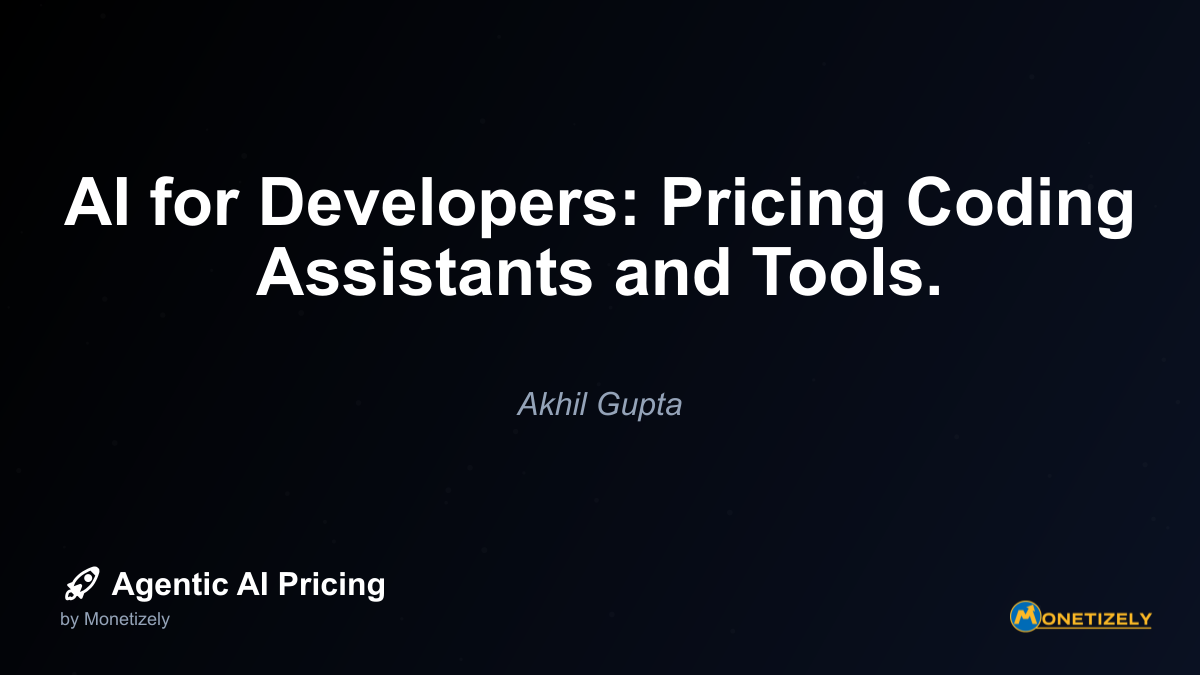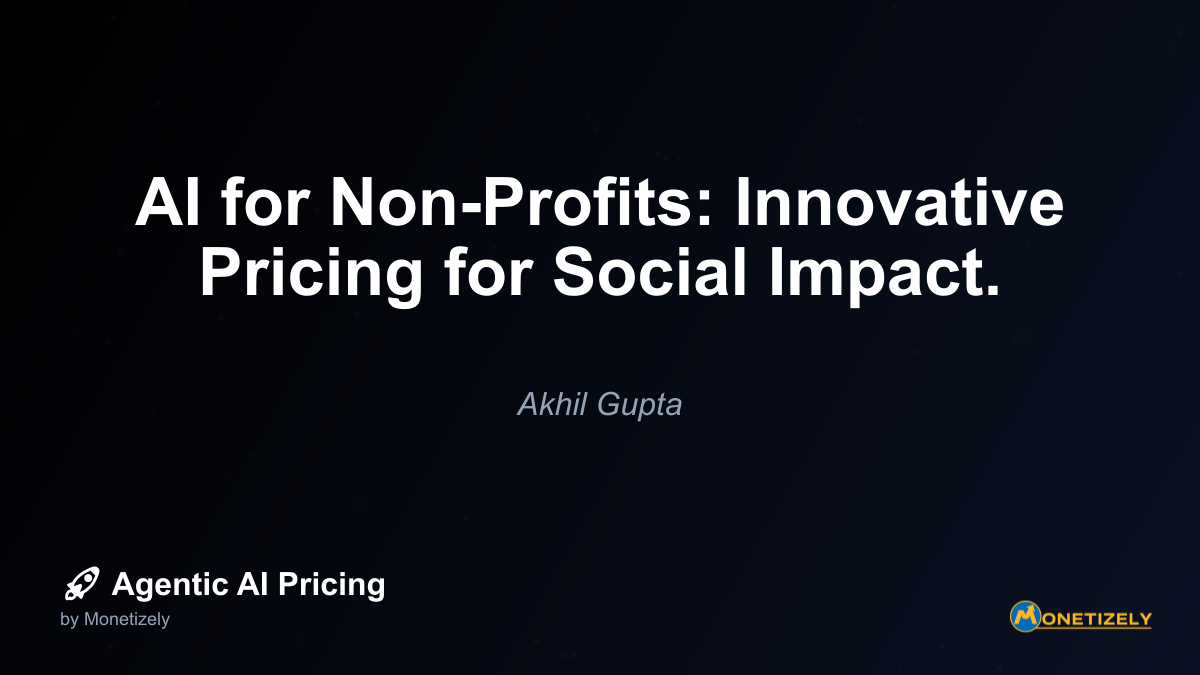· Akhil Gupta · Industry Insights · 9 min read
AI in Financial Services: Pricing High-Value Intelligence Tools.
AI and SaaS Pricing Masterclass
Learn the art of strategic pricing directly from industry experts. Our comprehensive course provides frameworks and methodologies for optimizing your pricing strategy in the evolving AI landscape. Earn a professional certification that can be imported directly to your LinkedIn profile.

AI has revolutionized the financial services industry, transforming how professionals analyze markets, assess risk, and make critical investment decisions. The integration of artificial intelligence into financial tools has created a new category of high-value intelligence platforms that command premium pricing structures reflecting their substantial impact on business outcomes.
Financial institutions—from global banking conglomerates to boutique investment firms—increasingly rely on AI-powered solutions to maintain competitive advantage in a data-saturated marketplace. These sophisticated platforms leverage machine learning, natural language processing, and predictive analytics to deliver insights that would be impossible for human analysts to generate independently at comparable speed and scale.
The Evolution of Financial Intelligence Tools
Traditional financial analysis relied heavily on human expertise, spreadsheet modeling, and manual research processes. Analysts would spend countless hours sifting through financial statements, news reports, and market data to identify patterns and generate insights. This approach, while valuable, suffered from inherent limitations in processing capacity, speed, and susceptibility to human bias.
The introduction of AI-powered intelligence tools has fundamentally altered this landscape. Modern platforms can ingest and analyze millions of data points from diverse sources—including regulatory filings, earnings calls, news articles, social media sentiment, and alternative data—to identify relevant patterns and generate actionable insights within seconds.
This evolution represents more than incremental improvement; it’s a paradigm shift in how financial intelligence is gathered, processed, and leveraged for decision-making. The most sophisticated tools now incorporate multiple AI technologies:
- Natural Language Processing (NLP): Parsing and extracting meaning from unstructured text data across multiple languages
- Machine Learning: Identifying patterns and anomalies across vast datasets
- Predictive Analytics: Forecasting market movements and risk scenarios
- Knowledge Graphs: Mapping relationships between companies, executives, and market events
- Sentiment Analysis: Gauging market perception and emotional responses to financial developments
Market Leaders in Financial AI Intelligence
Several platforms have emerged as leaders in this space, commanding significant price premiums for their specialized capabilities:
AlphaSense has positioned itself as a market intelligence platform used by over 2,000 enterprise customers, including major investment banks and hedge funds. The platform applies AI to search and analyze millions of documents, including company filings, earnings calls, and research, identifying relevant information that might otherwise be missed.
Bloomberg Terminal has evolved beyond its traditional role to incorporate sophisticated AI capabilities, maintaining its position as an essential (if expensive) tool for financial professionals. With annual licenses reportedly costing around $24,000 per user, Bloomberg’s pricing reflects its entrenched value proposition and continuous AI innovation.
Kensho (acquired by S&P Global for $550 million) specializes in analyzing the impact of global events on asset prices, using natural language processing to interpret news and predict market movements.
Sentieo combines financial document search, market data, and collaborative tools with AI-driven insights, positioning itself as a next-generation financial research platform.
These platforms represent the high end of the market, where annual seat licenses frequently range from $10,000 to $25,000 or more—pricing that would be unthinkable for most SaaS products but is justified in the financial context.
The Value Drivers Behind Premium Pricing
The extraordinary pricing power of financial AI tools stems from several interconnected value drivers:
1. Direct Connection to Revenue Generation
Unlike operational software that might improve efficiency or reduce costs, financial intelligence tools directly support revenue-generating activities. When a single insight can inform a multi-million-dollar investment decision, the ROI calculation becomes straightforward, even at premium price points.
As one hedge fund manager noted in an industry interview: “If a $20,000 annual license helps us identify even one opportunity that generates a 0.5% better return on a $10 million position, it’s paid for itself five times over.”
2. Information Asymmetry Advantage
Financial markets reward those with superior information and analysis. AI tools create information asymmetry by surfacing insights that might not be apparent to competitors using less sophisticated tools. This advantage—even if temporary—can translate to significant financial gains.
3. Regulatory Compliance and Risk Mitigation
Financial institutions operate in heavily regulated environments where compliance failures can result in substantial penalties. AI tools that help identify regulatory risks or ensure compliance with complex requirements deliver value through risk mitigation, not just opportunity identification.
4. Time Compression
In financial markets, speed often equals advantage. AI tools that reduce research time from days to minutes create tangible value by allowing professionals to act on insights faster than competitors. This time compression justifies premium pricing, especially in fast-moving markets where timing is critical.
5. Cognitive Augmentation
Rather than replacing analysts, the best financial AI tools augment human capabilities by handling data-intensive tasks and surfacing patterns that might otherwise remain hidden. This cognitive augmentation allows financial professionals to focus on higher-value activities like strategy development and client relationships.
Pricing Models for Financial AI Tools
The pricing structures for financial AI intelligence platforms reflect their positioning as high-value, professional tools rather than mass-market software. Common approaches include:
Tiered Seat Licensing
Most platforms employ tiered annual seat licenses with significant price points:
- Basic Tier: Often starting at $5,000-$10,000 per user annually, providing core functionality
- Professional Tier: $12,000-$20,000 per user annually, adding advanced analytics and data sources
- Enterprise Tier: $20,000+ per user annually, including customization, API access, and dedicated support
Data Volume and Source Pricing
Beyond seat licenses, many platforms charge based on:
- Number of data sources accessed
- Volume of documents processed
- Historical data depth
- Frequency of updates
API and Integration Pricing
For firms that integrate AI intelligence directly into proprietary systems:
- API call volume-based pricing
- Data export fees
- Custom integration services
Enterprise Agreements
Large financial institutions typically negotiate enterprise-wide agreements that may include:
- Volume discounts on seat licenses
- Custom development
- Dedicated support teams
- On-premises deployment options
Value-Based Pricing Strategies
What’s particularly instructive about financial AI tools is their embrace of value-based pricing rather than cost-plus or competitor-based approaches. These platforms price according to the value they deliver, not their development costs or competitor benchmarks.
This approach manifests in several ways:
Role-Based Differentiation
Many platforms charge different rates based on the user’s role:
- Portfolio managers (who make direct investment decisions) pay premium rates
- Research analysts pay intermediate rates
- Support staff pay lower rates
This differentiation reflects the varying value delivered to different roles, with pricing aligned to the financial impact of each user’s decisions.
Industry Vertical Pricing
Pricing often varies by industry vertical, with higher rates for:
- Hedge funds and asset managers (where decisions directly impact investments)
- Investment banks (where insights influence large transactions)
- Private equity firms (where insights inform acquisition targets)
Lower rates might apply to corporate users or academic institutions, reflecting different value equations.
Outcome-Based Components
Some cutting-edge platforms have begun experimenting with outcome-based pricing components:
- Success fees tied to documented ROI
- Performance-based pricing tiers
- Value-sharing models for proprietary strategies
While still relatively rare, these approaches represent the frontier of value-based pricing in financial AI.
Lessons for Agentic AI Pricing
The premium pricing models established by financial intelligence platforms offer valuable lessons for pricing agentic AI solutions more broadly:
1. Value Measurement is Essential
Financial AI tools succeed in commanding premium prices because they operate in a domain where value is quantifiable. Users can measure the impact of better decisions in dollars and cents, creating a clear ROI case.
For agentic AI in other domains, establishing clear value metrics is equally critical. Without quantifiable outcomes, premium pricing becomes harder to justify.
2. Domain Specificity Commands Premiums
The most expensive financial AI tools are deeply specialized for financial use cases, not general-purpose platforms. This domain specificity—with features, data, and interfaces tailored to financial workflows—justifies premium pricing.
Agentic AI solutions targeting specific industry verticals or specialized use cases can similarly command higher prices than general-purpose alternatives.
3. Integration with Decision Workflows is Critical
Financial AI tools command premium prices because they integrate seamlessly with decision-making workflows. They don’t just provide information; they deliver it in formats that directly support high-value decisions.
Successful agentic AI pricing strategies should similarly focus on integration with critical decision points rather than standalone functionality.
4. Professional Tools Support Professional Pricing
Financial intelligence platforms position themselves as professional tools for sophisticated users, not mass-market applications. This positioning supports premium pricing by emphasizing specialized capabilities and high-stakes use cases.
Agentic AI solutions can adopt similar positioning to support premium pricing models, clearly differentiating professional-grade offerings from consumer alternatives.
Implementation Challenges
Despite the clear value proposition, financial institutions face several challenges when implementing and pricing AI intelligence tools:
ROI Measurement Complexity
While financial decisions have clear monetary outcomes, attributing those outcomes to specific tools remains challenging. Did the trading profit result from the AI tool’s insight, the analyst’s interpretation, or market conditions?
This attribution challenge creates pressure for more sophisticated ROI measurement frameworks that can isolate the tool’s contribution to outcomes.
Integration with Legacy Systems
Many financial institutions operate complex technology ecosystems with legacy components. Integrating AI tools with these systems often requires significant investment, creating hidden costs beyond the stated license fees.
Successful vendors increasingly offer integration services and APIs to address this challenge, sometimes bundling these capabilities into premium pricing tiers.
Talent and Training Requirements
Even the most sophisticated AI tools require skilled users who understand both the technology and the domain. Financial institutions must invest in talent acquisition and training to fully leverage AI capabilities.
This human capital requirement represents an often-overlooked component of the total cost of ownership for financial AI tools.
Future Directions in Financial AI Pricing
As the market matures, several trends are emerging in how financial AI tools are priced and positioned:
Increased Personalization
Next-generation platforms are moving toward highly personalized experiences that adapt to individual users’ preferences, priorities, and decision-making styles. This personalization will likely support even more differentiated pricing based on individual value delivery.
Embedded AI Capabilities
Rather than standalone platforms, AI capabilities are increasingly embedded directly into existing financial workflows and systems. This integration changes the pricing equation, potentially shifting toward outcome-based models rather than seat licenses.
Specialized Micro-Services
Instead of monolithic platforms, some providers are unbundling capabilities into specialized micro-services with individual pricing. This approach allows institutions to assemble customized intelligence stacks with pricing aligned to specific use cases.
Conclusion
The premium pricing models established by AI-powered financial intelligence tools offer a compelling case study in value-based pricing for sophisticated technology. By directly connecting to high-value decisions, creating measurable advantages, and integrating with critical workflows, these platforms have established pricing power that far exceeds typical SaaS benchmarks.
For organizations developing agentic AI solutions in other domains, the financial intelligence sector provides valuable lessons in how to structure and justify premium pricing. The key insight is straightforward but powerful: when AI directly enhances high-value decisions with measurable outcomes, users will pay accordingly.
As agentic AI continues to evolve across industries, the pricing strategies pioneered in financial services will likely influence how value is captured in diverse sectors—from healthcare and legal services to manufacturing and logistics. The fundamental principle remains consistent: align pricing with the value delivered, not the cost of production.
Financial institutions that understand both the capabilities and limitations of AI-powered intelligence tools—and can accurately measure their impact on decision quality—will be best positioned to make sound investment decisions about these increasingly essential platforms.
Co-Founder & COO
Akhil is an Engineering leader with over 16+ years of experience in building, managing and scaling web-scale, high throughput enterprise applications and teams. He has worked with and led technology teams at FabAlley, BuildSupply and Healthians. He is a graduate from Delhi College of Engineering and UC Berkeley certified CTO.
Pricing Strategy Audit
Let our experts analyze your current pricing strategy and identify opportunities for improvement. Our data-driven assessment will help you unlock untapped revenue potential and optimize your AI pricing approach.




